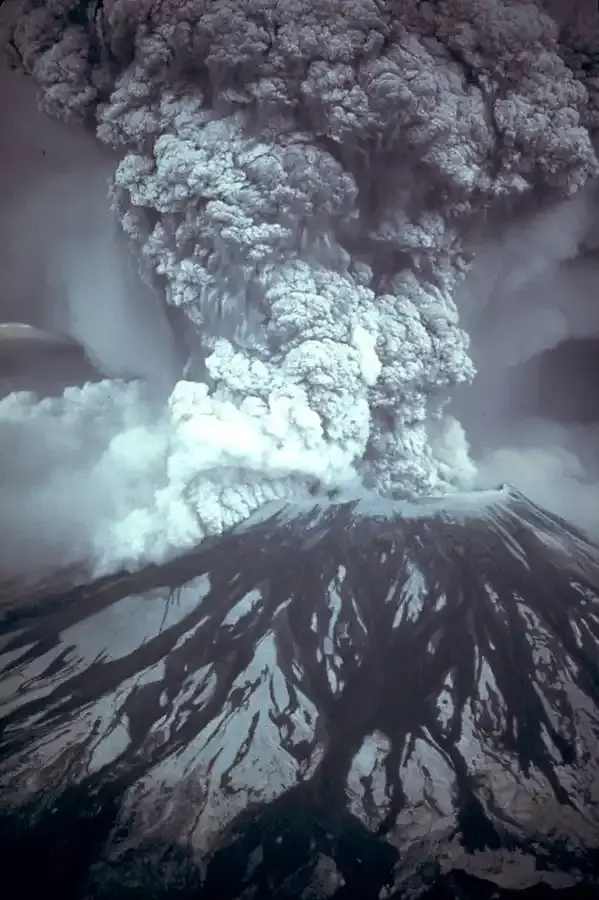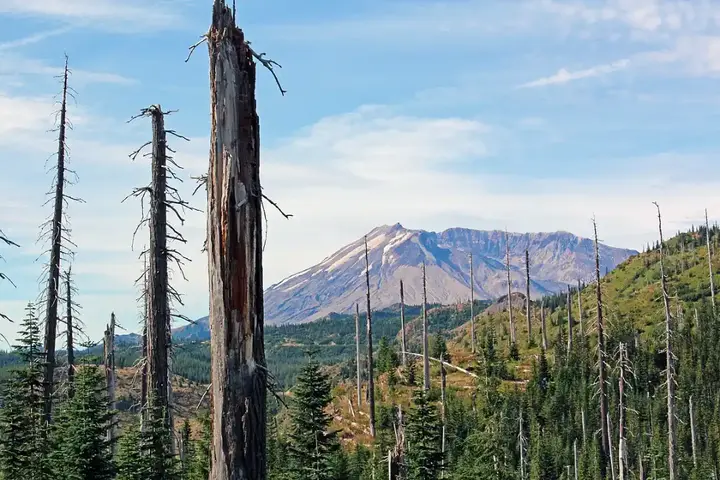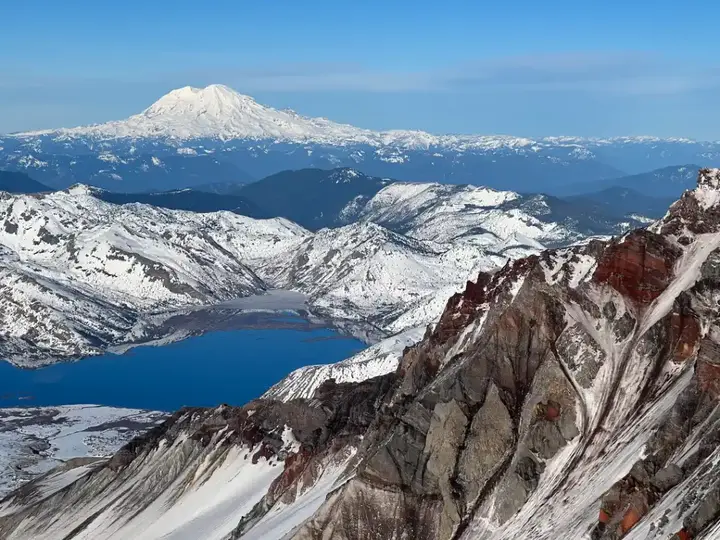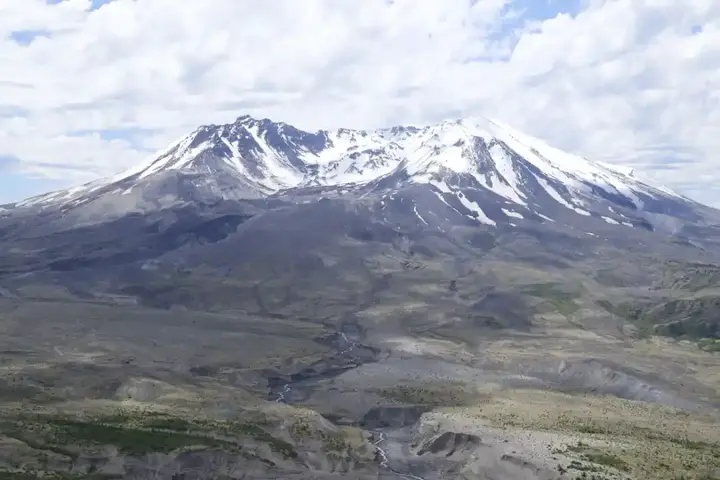Mount St. Helens blast and rebirth

Mount St. Helens is one of the most famous volcanoes in the United States, known for its devastating eruption on May 18, 1980. This explosion caused widespread destruction of the area around the mountain, as the enormous forces of nature radically changed the landscape. However, despite the massive destruction, the area has demonstrated an amazing natural capacity for recovery and reconstruction. In this article, we will review the details of the devastating explosion of Mount St. Helen, the repercussions it left behind, and how nature was able to reborn after this disaster.
Show key points
- Mount St. Helens is renowned for its catastrophic eruption on May 18, 1980, which drastically reshaped the landscape and caused widespread destruction.
- The eruption was triggered by a massive landslide followed by an explosive release of ash and gases, resulting in the deaths of 57 people and severe environmental damage.
- The disaster had long-lasting ecological effects, including the obliteration of forests, disruption of waterways, and the loss of wildlife habitats.
- ADVERTISEMENT
- Remarkably, the area began to regenerate soon after the eruption, with plants and animals slowly returning and reestablishing a balanced ecosystem.
- Natural processes, such as soil stabilization by pioneering plants, played a vital role in the gradual recovery and ecological restoration of the region.
- Today, Mount St. Helens serves as both an educational site and tourist attraction, drawing attention to the forces of geology and the resilience of nature.
- Beyond its history of destruction, the mountain symbolizes renewal and resilience, offering powerful lessons about Earth’s capacity for recovery.
Blast: The Angry Power of Nature

On the morning of May 18, 1980, Mount St. Helens experienced one of the most destructive volcanic eruptions in modern history. The events began with a series of earthquakes and earthquakes moving under the mountain, causing a large part of the mountain to suddenly collapse. This collapse released huge amounts of pressure, resulting in a massive explosion that released a huge cloud of ash and hot gases that spread rapidly across the surrounding area. This explosion destroyed everything in its path, from dense forests to rivers and houses. It also caused the death of 57 people and the injury of hundreds, in addition to huge material losses. This explosion was a powerful reminder of how powerful and furious nature is, and how beautiful areas can turn into areas of destruction in just a few moments.
Recommend
Repercussions of the disaster: the impact of the explosion on the environment and life

The volcanic eruption of Mount St. Helens not only affected immediate destruction, but also had long-lasting repercussions on the environment and wildlife in the area. The area of destruction spans a vast area, as forests have completely disappeared and fertile lands have turned into a barren landscape covered in volcanic ash. Waterways were also affected by the explosion, as rivers were filled with ash and volcanic rocks, which affected water quality and led to the death of many aquatic organisms. Wildlife in the area has been hit hard, with many animals losing their natural habitats and facing extinction. But despite all this destruction, there were early signs of nature's ability to recover. The first plants began to grow shortly after the explosion, demonstrating that the Earth still holds the seeds of life and that the natural cycle will continue despite everything.
Rebirth: The Natural Recovery of Mount St. Helens

Despite the massive destruction caused by the explosion, the area around Mount St. Helens has shown an amazing ability to recover and return to life. Over the following years, nature began a slow but continuous reconstruction. Plants are reappearing in burning lands, where leading plant species have played a large role in stabilizing the soil and rebuilding the ecosystem. Animals are also gradually returning to the area, as birds, insects and small animals have rebuilt their habitats in the new forests. This natural recovery would not have been possible without the vital role that natural processes play in restoring ecological balance. Today, Mount St. Helens is a great example of nature's power in recovering from major disasters, and it offers a valuable lesson in the importance of patience and faith in the Earth's healing power.
Tourism and Education: Mount St. Helens as an educational and tourist destination

After its explosion, Mount St. Helens became an important tourist and educational destination. The mountain annually attracts thousands of visitors and scientists who come to explore the area and learn from the lessons provided by nature. The visitor center was established in the area to provide comprehensive information about the eruption and its effects, as well as to show documentaries and interactive exhibits explaining the volcanic process. Visitors can walk the natural trails that take them through the areas affected by the explosion, where they can witness the natural healing process first-hand. This unique location not only provides an opportunity to enjoy the natural beauty of the region, but also offers an opportunity to learn about the power of nature and the importance of preserving the environment. By visiting Mount St. Helen, people can understand more how the Earth works and how disasters can be part of the planet's life cycle.

Mount St. Helens is a vivid example of nature's ability to recover and come back to life after major disasters. Despite the devastating explosion that destroyed everything in its path, the earth showed amazing power in recovering and rebuilding. Today, Mount St. Helens is not only a symbol of destruction, but also of the ability to rise from the ashes and return to life with greater force. The mountain is a lesson in resilience, and reminds us that life on the planet always finds its way back, no matter how great the challenges. If you are looking for a place that combines natural beauty with deep geological history, visiting Mount St. Helens will be an unforgettable experience that will enrich your knowledge and make you contemplate the power of nature and its continuous cycles.
![]()
Unexplained phenomena - a list that drives you crazy!
Marfa lights, glowing mysteriously in Texas deserts, and intricate crop circles bent into fields with no clear cause, both baffle scientists and spark theories from the natural to the supernatural. The Bermuda Triangle, too, remains a hotspot of intrigue, with ships and planes vanishing, leaving only questions and fascination behind. more- ADVERTISEMENT
![]()
Why do people buy? Simplifying the theory of purchase
Understanding why people buy is key in commerce—whether it's to meet basic needs, fulfill desires, or express identity. Buying behavior is shaped by psychological, social, economic, and marketing factors, and recognizing these helps create better marketing strategies that truly connect with consumers. more- ADVERTISEMENT
![]()
The Genius of Nature: 8 Amazing Technological Innovations Inspired by Nature
Nature inspires some of the coolest tech—like butterfly wings improving solar cells or kingfishers helping trains go quiet and fast. Even surgical needles got less painful thanks to mosquitoes. From firefly-inspired LEDs to Velcro born from prickly plants, the wild world is secretly shaping our everyday innovations. more- ADVERTISEMENT
![]()
The city of Rimini on the Adriatic coast with its Roman history
Rimini blends beachside charm with rich history—from ancient Roman arches to Renaissance castles. Wander through art-filled streets, savor local pasta and fish soups, and explore unique spots like the Jampalonga Library or Fellini's first home. By the sea or in town, Rimini never stops giving. more- ADVERTISEMENT
![]()
A book that may interest you - stop pleasing others
A book that might interest you - Stop People Pleasing more- ADVERTISEMENT
![]()
The solar system had nine planets. Maybe he's still doing it? Here's the latest space news today
Pluto’s “demotion” in 2006 marked the start of an exciting new chapter in space discovery, revealing a growing family of dwarf planets and pointing toward a possible mysterious ninth planet. With powerful tools like the James Webb Telescope, we’re closer than ever to uncovering strange new worlds—even beyond our solar system. more- ADVERTISEMENT
![]()
The Genius of Nature: 8 Amazing Technological Innovations Inspired by Nature
Nature has sparked incredible inventions—from quieter express trains shaped like kingfishers to painless needles modeled after mosquitoes. Even butterfly wings help improve solar cells. These smart ideas not only improve our daily lives but also open big doors in tech and business. more- ADVERTISEMENT
![]()
How to create a small online store for online sales?
Starting an online store is a smart move to sell your products and reach more people. Begin small, focus on unique items, choose a catchy store name, and use easy platforms like Shopify or Wix. Good design, secure payments, solid marketing, and great service are key to your store’s success. more- ADVERTISEMENT
![]()
Dubai Frame... Greatness lies in simplicity
Dubai Frame is a stunning landmark in Dubai offering breathtaking panoramic views from its transparent glass bridge. Visitors can journey through time with exhibitions showcasing Old Dubai, present-day marvels, and a futuristic vision of the city, all using immersive technology and interactive experiences—plus, coffee 150 meters above ground! more- ADVERTISEMENT
![]()
The Rise of the Reds from the Ashes: The Epic Story of Liverpool Football Club's Triumphs and Setbacks
Liverpool FC’s journey is one of passion, heartbreak, and glory. From humble beginnings in 1892 to conquering Europe under Klopp, it’s the setbacks, spirit, and resilience that make fans fall in love. At Anfield, through every triumph and tragedy, the Reds never walk alone. more- ADVERTISEMENT




















